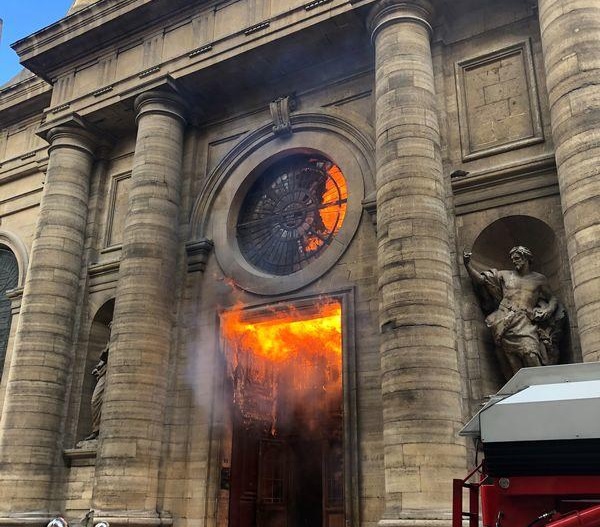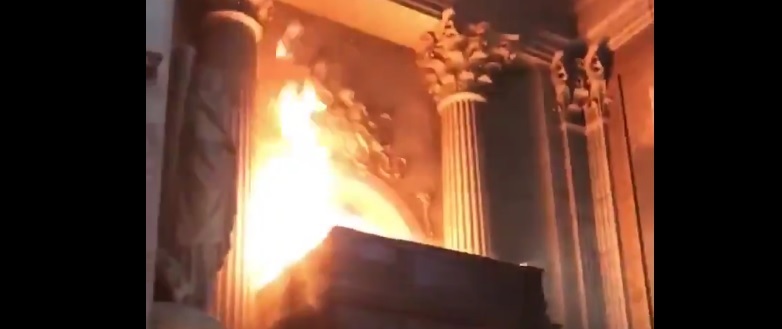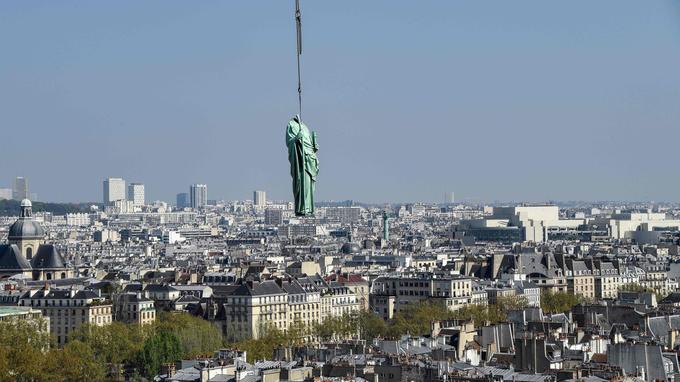Just 1 month ago one of the most famous churches in Paris, St. Sulpice, was set on fire, eventually revealed to be arson.
Historic St. Sulpice church caught fire in Paris on Sunday. The blaze had damaged the main door as well as an internal staircase.

sputniknews.com
CATHOLIC CHURCHES ARE BEING DESECRATED ACROSS FRANCE—AND OFFICIALS DON’T KNOW WHY
3/21/19 AT 9:04 AM EDT
France has seen a spate of attacks against Catholic churches since the start of the year, vandalism that has included arson and desecration.
Vandals have
smashed statues, knocked down tabernacles, scattered or destroyed the Eucharist and torn down crosses, sparking fears of a rise in anti-Catholic sentiment in the country.
Last Sunday, the historic Church of St. Sulpice in Paris was set on fire just after midday mass on Sunday,
Le Parisien reported, although no one was injured. Police are still investigating the attack, which firefighters have confidently attributed to arson.
Built in the 17th century, St. Sulpice houses three works by the Romantic painter Eugene de la Croix, and was used in the movie adaptation of
The Da Vinci Code, by Dan Brown.
Last month, at the St. Nicholas Catholic Church in Houilles, in north-central France,
a statue of the Virgin Mary was found smashed, and the altar cross had been thrown on the ground, according to
La Croix International, a Catholic publication.
Also in February, at Saint-Alain Cathedral in Lavaur, in south-central France,
an altar cloth was burned and crosses and statues of saints were smashed. The attack prompted Lavaur Mayor Bernard Canyon to say in a statement: “God will forgive. Not me.”
And in the southern city of Nimes, near the Spanish border, vandals looted the altar of the church of Notre-Dame des Enfants (Our Lady of the Children) and
smeared a cross with human excrement.
Consecrated hosts made from unleavened bread, which Catholics believe to be the body of Jesus Christ,
were taken and found scattered among rubbish outside the building.
Bishop Robert Wattebled of Nimes said in a statement: “This greatly affects our diocesan community. The sign of the cross and the Blessed Sacrament have been the subject of serious injurious actions.
“This act of profanation hurts us all in our deepest convictions,” he added, according to
The Tablet, which reported that in February alone there had been a record 47 documented attacks on churches and religious sites.
The Vienna-based Observatory of Intolerance and Discrimination Against Christians in Europe, which was founded in cooperation with the Council of European Bishops Conferences (CCEE) but is now independent said there had been
a 25 percent increase in attacks on Catholic churches in the first two months of the year, compared with the same time last year.
Its executive director, Ellen Fantini, told
Newsweek that
while in many cases the motive for the attacks was not known, France faced growing problems with anti-Christian violence, especially by anarchist and feminist groups.
“I think there is a rising hostility in France against the church and its symbols," but "it seems to be
more against Christianity and the symbols of Christianity.
“These attacks are on symbols that are really sacred to parishioners, to Catholics. Desecration of consecrated hosts is a very personal attack on Catholicism and Christianity, more than spray-painting a slogan on the outside wall of a church.”
She said that while France had a long tradition of secularism, it was seen as a culturally Christian country, and so any "attack on the church as a symbol of religion was also an attack on authority and patrimony.
"The pressure is coming from the radical secularists or anti-religion groups as well as feminist activists who tend to target churches as a symbol of the patriarchy that needs to be dismantled," she added.
On February 9, the altar at the church of Notre-Dame in Dijon, the capital of the Burgundy region, was also broken into. The hosts were taken from the tabernacle, which adorns the altar at the front of the church, and scattered on the ground.
Last month, the Prime Minister Edouard Phillipe met French church leaders and said in a statement: “In our secular Republic, places of worship are respected. Such acts shock me and must be unanimously condemned.”
Senior Figures within the French Catholic Church expressed their sorrow at the rise in attacks on symbols of their faith.
Last month, the secretary general of the Bishops’ Conference, Olivier Ribadeau-Dumas, told France Culture that desecration of a church was not the same as a common burglary.
“To open the tabernacle, to take the hosts and to profane what for us is the basis of our faith, that is to say the presence of Jesus Christ in the hosts is something that is terrible for us.”






